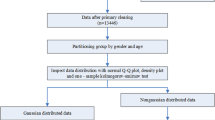Abstract
Serum concentrations of copper and zinc were measured by flame atomic absorption spectrophotometry in 560 Kuwaitis aged from 15 to 80 yr who were in apparent good health to establish reference ranges and determine the prevalence of the deficiency of the trace metals. Zinc/copper ratios were derived by calculation. Because the mean±SD (µM) for copper in females (24.9±7) was significantly higher (p<0.0001) than in males (21.0±5.8) and vice versa for zinc (17.0±3.5 [males] vs 15.5±3.4 [females]) and zinc/copper ratios (0.87±0.28 [males] vs 0.67±0.27 [females]), gender-specific reference ranges were established in addition to reference ranges for the total population. The reference range for zinc was closer to those reported for other populations than was copper. Body mass index (BMI) and copper values were lower and the zinc/copper ratio was higher in the young (15–24 yr) compared to the older subjects. Copper concentrations were positively associated with BMI values (r=0.302, p<0.0001). Smokers had significantly lower (p=0.011) BMI than nonsmokers. The prevalence of copper and zinc deficiency, 0.36% and 0.53%, respectively, was low. Generally, the values for serum copper and zinc obtained for the Kuwaiti population studied suggest adequate dietary intake of the trace metals.
Similar content being viewed by others
References
J. J. Strain, Newer aspects of micronutrients in chronic disease: copper, Proc. Nutr. Soc. 53, 583–598 (1994).
L. M. Sayre, G. Perry, and M. A. Smith, Redox metals and neurodegenerative disease, Curr. Opin. Chem. Biol. 3, 220–225 (1999).
L. M. Klevay, L. Inman, L. K. Johnson, M. Lawler, J. R. Mahalco, D. B. Milne, et al., Increased cholesterol in plasma in a young man during experimental copper depletion, Metabolism 33, 1112–1118 (1984).
D. Medeiros, L. Pellum, and B. Brown, Serum lipids and glucose associated with haemoglobin levels and copper and zinc intake in adults. Life Sci. 32, 1897–1904 (1983).
B. Halliwell and J. M. C. Gutteridge, The chemistry of free radicals and related reactive species, in Free Radicals in Biology, 3rd ed., B. Halliwell and J. M. C. Gutteridge, eds., Oxford University Press, Oxford, pp. 36–104 (1999).
H. H. Sanstead, Requirements and toxicity of essential trace elements, illustrated by zinc and copper, Am. J. Clin. Nutr. 61, 621–624 (1995).
R. Cousins, Metal elements and gene expression, Annu. Rev. Nutr. 14, 449–469 (1994).
W. M. Dunlap, G. W. James, and D. M. Hume, Anemia and neutropenia caused by copper deficiency, Ann. Intern. Med. 80, 470–476 (1974).
C. R. Peterson and J. Burns, Copper deficiency in infancy, J. Clin. Biochem. Nutr. 4, 175–190 (1988).
D. A. Frankel, Supplementation of trace elements in parenteral nutrition: rationale and recommendations, Nutr. Res. 13, 583–596 (1993).
S. Safai-Kutti, Oral zinc supplementation in anorexia nervosa. Acta Psychiatrica Scand. Suppl. 361, 14–17 (1990).
T. Hallbrook and E. Lanner, Serum zinc and healing of various leg ulcers, Lancet 2, 780–782 (1972).
J. C. Smith, G. P. Butrimovitz, and W. C. Purdy, Direct measurement of zinc in plasma by atomic absorption spectroscopy, Clin. Chem. 25, 1487–1492 (1979).
L. G. P. J. Aggett, Physiology and metabolism of essential trace elements, Clin. Endocrinol. Metab. 14, 513–543 (1985).
P. J. Aggett, Essential minerals and trace element nutriture methodology, in Nutritional Status Assessment. A Manual for Population Studies, F. Fidanza, ed., Chapman & Hall, London, pp. 385–398 (1991).
F. Fischbach, Standards for tests of microminerals (trace), in Nurses Quick Reference to Common Laboratory Diagnostic Tests, 2nd ed., J. F. Fischbach, ed., Lippincott, New York, pp. 482–489 (1998).
A. Taylor, Detection of essential trace elements, Ann. Clin. Biochem. 33, 486–510 (1996).
P. A. Walravens and K. M. Hambidge, Growth of infants fed a zinc-supplemented formula, Am. J. Clin. Nutr. 29, 1114–1121 (1976).
B. S. Douglas, D. R. Lines, and C. A. Tse, Serum zinc level in New Zealand children, NZ Med. J. 83, 192–194 (1976).
K. Kasperek, L. E. Feinendegen, I. Lombeck, and H. J. Brewer, Serum zinc concentration during childhood, Eur. J. Pediatr. 126, 199–202 (1977).
G. E. Sechler, Vitamins, metals and nutritional factors, in Professional Practice in Clinical Chemistry: A Review, D. R. Dafour and P. J. Howantz, eds., American Association for Clinical Chemistry, and The National Academy of Clinical Biochemistry, Washington, DC, pp. 615–634 (1996).
D. B. Milne and P. E. Johnson, Assessment of copper status: effect of age and gender on reference ranges in healthy adults, Clin. Chem. 39, 683–687 (1993).
H. H. Sanstead, Copper bioavailability, requirements, Am. J. Clin. Nutr. 35, 809–814 (1982).
C. Hill and G. Matrone, Chemical parameters in the study of in vivo and in vitro interactions of transition elements, Fed. Proc. 29, 1474–1481 (1970).
L. Klevay, Hypercholesterolemia in rats produced by an increase in the ratio of zinc to copper ingested, Am. J. Clin. Nutr. 26, 1060–1068 (1973).
J. Lee, L. N. Kolonel, and M. W. Hinds. Relative merits of the weight-correlated-forheight indices, Am. J. Clin. Nutr. 34, 2521–2529 (1981).
J. A. Colliver, S. Frank, and A. Frank, Similarity of obesity indices in clinical studies of obese adults: a factor for analytical study, Am. J. Clin. Nutr. 38, 640–647 (1983).
A. E. Thomas, D. A. McCay, and B. M. Cutlip, Anomograph method for assessing body weight, Am. J. Clin. Nutr. 29, 302–304 (1976).
I. D. Caterson, Obesity, part of the metabolic syndrome, Clin. Biochem. Rev. 18, 11–21 (1997).
H. H. Sanstead, Zinc nutrition in the United States, Am. J. Clin. Nutr. 26, 1251–1260 (1973).
P. Mason, Dietary sources of copper and zinc, in Handbook of Dietary Supplements. Vitamins and Other Health Supplements, P. Mason, ed., Blackwell Science, Cambridge, MA, pp. 64,213–214 (1995).
Author information
Authors and Affiliations
Rights and permissions
About this article
Cite this article
Abiaka, C., Olusi, S. & Al-Awadhi, A. Reference ranges of copper and zinc and the prevalence of their deficiencies in an Arab population aged 15–80 years. Biol Trace Elem Res 91, 33–43 (2003). https://doi.org/10.1385/BTER:91:1:33
Received:
Accepted:
Issue Date:
DOI: https://doi.org/10.1385/BTER:91:1:33




